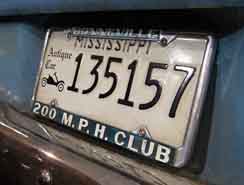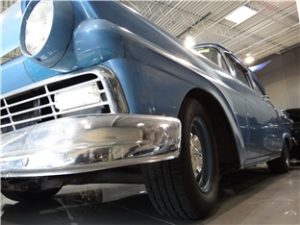Blue Angel
 Yesterday, I saw an automobile that prompted me to reflect upon my heritage. I remembered my deceased half-brother, and a time and place of growing up as a kid..
Yesterday, I saw an automobile that prompted me to reflect upon my heritage. I remembered my deceased half-brother, and a time and place of growing up as a kid..
On the display floor at the Roadster Shop in Mundelein a 1957 Ford Fairlane 500 caught my eye. You could say that the mid 1950’s were the apogee days for the big three: Ford, Chevrolet, and Chrysler. The 1957 Ford  sat like a blue angel, out of a time warp. The old girl was surrounded by high-tech 21st century custom built street rods, —not unlike a farm girl incongruous among alluring fashionistas wearing Prada and Gucci.
sat like a blue angel, out of a time warp. The old girl was surrounded by high-tech 21st century custom built street rods, —not unlike a farm girl incongruous among alluring fashionistas wearing Prada and Gucci.
I walked around the car and smiled to see the  Mississippi license plate. I felt the car somehow had to be from the South. I thought of my half brother, older than I, who I visited frequently as I grew up. He grew up in tobacco country, in rural Johnston County, North Carolina. I envied him. He was a superb hunter, fisherman, a well respected farmer and mechanic. I remember cars of this
Mississippi license plate. I felt the car somehow had to be from the South. I thought of my half brother, older than I, who I visited frequently as I grew up. He grew up in tobacco country, in rural Johnston County, North Carolina. I envied him. He was a superb hunter, fisherman, a well respected farmer and mechanic. I remember cars of this  vintage parked under the big oak tree, by the dirt driveway which led to his front porch. Later in his life, Billy Coats owned a automatic transmission repair shop that was so well regarded, that GM dealers brought their warranty work to his shop for repair. He and his fellow mechanics were equal or better than the factory trained mechanics employed in the dealership service departments.
vintage parked under the big oak tree, by the dirt driveway which led to his front porch. Later in his life, Billy Coats owned a automatic transmission repair shop that was so well regarded, that GM dealers brought their warranty work to his shop for repair. He and his fellow mechanics were equal or better than the factory trained mechanics employed in the dealership service departments.
I was eight years old when this 1957 Fairlane 500 was brand new. This one looks as if it was stored in a barn for the last 50 years. The paint job  looks as if it was executed by some past owner, rather than by a professional paint shop. The paint, a simple cornflower blue, appears vintage, 20th century.
looks as if it was executed by some past owner, rather than by a professional paint shop. The paint, a simple cornflower blue, appears vintage, 20th century.
A look under the hood reveals the hidden magic. The 406 cubic inch motor was Ford’s entry into the muscle car era that was to come in the 1960s. Ford stroked the 390 motor to produce more horsepower to  compete with the General Motors and Chrysler muscle cars. This one has a single four-barrel carburetor, and what might be original Ford exhaust headers. The headers on the car show a lot of service. Under the hood is the big V-8 motor, all mechanical, no computers, —the hallmark of a bygone industrial age.
compete with the General Motors and Chrysler muscle cars. This one has a single four-barrel carburetor, and what might be original Ford exhaust headers. The headers on the car show a lot of service. Under the hood is the big V-8 motor, all mechanical, no computers, —the hallmark of a bygone industrial age.
 A glance into the interior of the car transported me back to my high school days when street racing was not unusual. A front bench seat, worn, stained with the passage of time contrasts with a Hurst four-speed shifter mounted on the floor between the driver and the passenger side of the car. On the driver side, the dashboard displays a collection of aftermarket performance gages which were essential to precisely control engine RPM, to monitor oil pressure, and of course the mile per hour speed. The round Steward Warner Tachometer is a familiar sight. How many times have I seen the needle wind right toward the red line? The tachometer needle arcs right with each shift and the engine screams; there’s a odor of gasoline, oil and rubber. That’s Nirvana.
A glance into the interior of the car transported me back to my high school days when street racing was not unusual. A front bench seat, worn, stained with the passage of time contrasts with a Hurst four-speed shifter mounted on the floor between the driver and the passenger side of the car. On the driver side, the dashboard displays a collection of aftermarket performance gages which were essential to precisely control engine RPM, to monitor oil pressure, and of course the mile per hour speed. The round Steward Warner Tachometer is a familiar sight. How many times have I seen the needle wind right toward the red line? The tachometer needle arcs right with each shift and the engine screams; there’s a odor of gasoline, oil and rubber. That’s Nirvana.
All of this fills me with nostalgia, affection for what is past, now a memory. Yet it is more than a memory, as those experiences have made me the person that I am as I write this. I think of past friends, of hours spent at the drag strip with other guys. Memories, of fumbling with wrenches, oil stained fingers, of contact with the materials out of which our civilization is made.
I would not have it any other way.